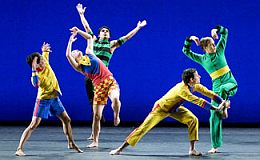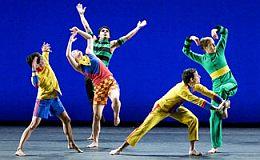
Too often people think of music as merely an accompaniment to dance, a means by which beautiful bodies keep in rhythm while tracing out a narrative or sketching a dynamic pattern across the wide stage-spaces. But the truth is that music, for any great choreographer or dancer, is the be-all and end-all of dance — the true muse who inspires and leads the dancer to the heart of emotion and thought.
Mark Morris has done more than claim that his dance group “is a music organization”; he has consistently brought high-quality music and musicans to his company performances. The music is always live, and in the Bay Area it has been performed by top-notch groups like the Philharmonia Baroque Orchestra, the Berkeley Symphony, and UC Berkeley’s choruses.
The MMDG always presents a premiere during its stay in Berkeley and this year they bring two West Coast premieres: Visitation, performed to Beethoven’s Sonata No. 4 for cello and piano, Op. 102; and Empire Garden, set to Charles Ives’ trio for piano, violin, and cello. The third piece on the program, called V, is danced to Schumann’s Quintet in E-flat for piano and strings.
Here is an uncommon combination of music. The Beethoven sonata's tender conversation between instruments morphs into a bright tempo that the choreographer describes as “sort of deranged and private and stormy.” The Ives trio is a comic mélange, full of the busyness of American life and laced with popular tunes and the occasional lapse that folds gently into the wistful and the sentimental; all of this is sandwiched between melancholic melodies, dark rhythms, and dissonant lyricism. The Schumann is one of his loveliest chamber pieces.
Unusual, however, is the name of Morris’ musical game, and he is especially fond of intriguing orchestrations and exotic instrumentation. He laughingly tells the story of a critic who complained that, when in Berkeley, Morris availed himself too much of the richly diverse musical community: “Too much new stuff with too many musicians,” remarks Morris. “I’m sorry. I like to do that.”
Even more to his credit, Morris has employed the original music, working directly from the composers’ scores and shunning orchestral versions of dance music that have grown flaccid over the years. Robert Cole, the former director of Cal Performances and a longtime collaborator with Morris, brought Morris’ version of Tchaikovsky’s The Nutcracker to Zellerbach Hall in 1996. As a musician, Cole, who had seen the show in New York several years previously, had been struck by the unusual rhythms used in MMDG’s The Hard Nut, only to find out later, when he conducted the orchestra for a Berkeley production, that those rhythms were in fact mostly Tchaikovsky’s, notated clearly in the score but ignored by generations of choreographers who were less inspired and less committed to the music.
In 2008 Morris pulled off a musical coup by using Prokofiev’s original music for his Romeo and Juliet, On Motifs of Shakespeare — not the music that we are familiar all with, which was filtered through the Russian state’s art bureaucrats, but the music Prokofiev wrote, which had never been performed and had only recently been discovered in the state archives in Moscow. The difference was amazing: The music was raw and energetic, vigorous yet sensitive. For days afterward, people wandered into Amoeba Music, looking for that version of Prokofiev’s Romeo and Juliet, a version that remains unavailable.
And what about the dance? What comes out of Morris’ partnership with music is altogether wonderful. Witty and lyrical, he and his dancers show another facet of music, revealing it with passion, intelligence, and supreme artistic skill.

